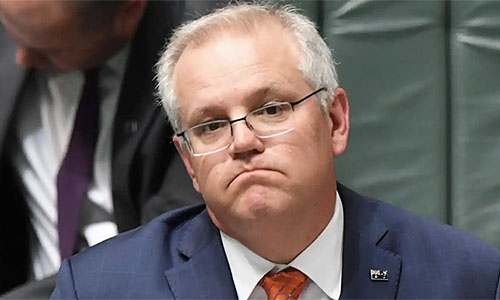
AUSTRALIA’S military build-up is on track to dwarf Germany, France and Britain as it responds to Chinese hostility in the Indo-Pacific region.
Prime Minister Scott Morrison on Wednesday announced a massive war chest taking annual military spending from this year’s US$35b up to US$61.2b by 2030.
This is approaching Russia’s current defence budget of US$61.6b a year. The former Soviet nation has a heavily nuclearised arsenal and is considered the world’s second most powerful military power – slightly ahead of China at third.
According to the Global Firepower rankings the US is ranked first. France, with a US$52.3b annual defence spend, Britain (US$54.8b) and Germany (US$48.5b) are ranked 7th, 8th and 13th respectively. Australia currently sits at 19th.
CHALLENGING
By massively increasing Australia’s defence spending last week, the Prime Minister effectively blew off its 2 per cent of GDP target.
PM Morrison described the current unrest in the Indo-Pacific as “one of the most challenging times we have known since the 1930s and early 1940s”.
He said strategic relationships in the region were under “almost irreversible strain”.
“The Indo-Pacific is the epicentre of rising strategic competition … it is the focus of the dominant global contest of our age,” Mr Morrison said in a speech at the Australian Defence Force Academy in Canberra on July 1.
The 10 year defence budget increases from US$372b set in 2016 to US$477b announced last week and includes US$225b in “capability investment”.
As China’s aggression ramps up towards Hong Kong, India, Taiwan and Vietnam – as well as towards Australia – PM Morrison plans to boost the nation’s offensive capabilities.
MISSILES
It will deploy US$660m of US-built long-range anti-ship missiles as well as beef up cyber security and increase military personnel.
Former Defence Department deputy secretary of strategy Mr Peter Jennings said the Prime Minister had announced a defence plan that, in maturity, looks more like 3.5 per cent of GDP.
“In the last Cold War, defence budgets tended to be 3.2 to 3.5 per cent of GDP. If the 1930s-style slide to war continues, that’s where our defence spending must head too,” Mr Jennings wrote in The Australian newspaper on July 2.
“Morrison should now apply his strategic lens to Australia’s thin diplomatic effort in Southeast Asia. Leadership carries cost. We must work with the region to show that it’s possible to push back against PRC domination.”
WASHINGTON
Mr Jennings, who is currently the executive director of the Australian Strategic Policy Institute, said Australia’s “step-up” was as important to Washington as it is to Canberra.
“Any major war Australia is involved in will most likely start in maritime Southeast Asia,” he said. “Australia will not be operating alone. The aim is to keep our opponents as far as possible from our land mass.
“A reasonably educated guess is that US$41b of the US$225b is free to be allocated to long-range missiles, hypersonic and direct energy weapons, autonomous land, sea and air vehicles, satellite constellations and amphibious ships.”
Prime Minister Morrison said the military build-up did not assume isolated action by Australia.
“It means integration with other partners. That’s obviously the US but it also means engaging with India, Japan and Indonesia,” Mr Morrison said.
“We are long engaged with Singapore and are doing peacekeeping partnerships with Vietnam.
“The purpose is to achieve a strategic balance within the Indo-Pacific.”
International defence spending comparisons have been sourced from the Institute of Strategic Studies (2019 Defence Budgets). To allow comparisons, the announced Australian defence spend increases have been converted to US dollars using the 10 year average exchange rate of 0.83.PC












Why don’t we just park four US nuclear subs in our major ports and service them by building a nuclear capability. Save us $80billion!
Much of this package includes measures that Senator General Jim Molan has been advocating. Just shows how important it is that he has a seat at the table because of his appointment to the Senate vacancy and just how stupid it was to relegate him to an unwinnable spot in the 2019 election.
I am not privy to the Liberal Party machinations but it seems to be a pity that Molan did not stand for Eden Monaro where he is loved and would likely have won another lower house seat for the Libs and left a Senate vacancy which again could have been filled by a Lib.
I think you might be deluded into thinking people actually think these things through!